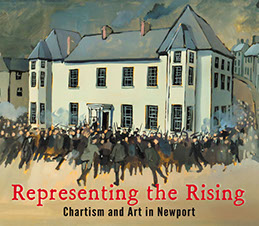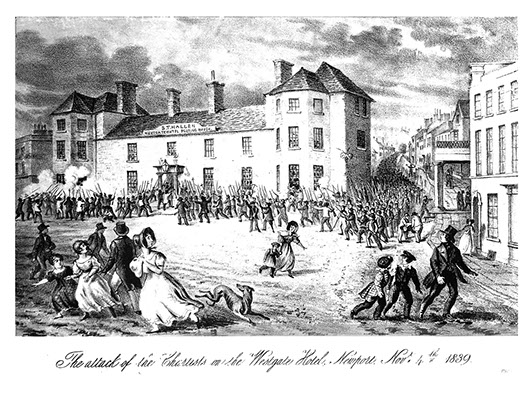
Representing the Rising
Chartism & Art in Newport
 The Newport Rising of 1839 has captured the imagination of the inhabitants of Gwent for many years. It was the last large-scale armed insurrection in Britain, instigated by Welsh Chartists demanding the right to vote, and resulted in the deaths of at least 22 Chartists. It also led to the last mass treason trial in British history, which was held at Monmouth. John Frost, Zephaniah Williams, and William Jones were eventually transported to Tasmania, while five others were imprisoned in London’s Millbank Penitentiary, all having initially received death sentences for their involvement in the Rising. It was an event that shocked the entire nation and was seen as, perhaps, the greatest challenge to the integrity and confidence of early Victorian society.
The Newport Rising of 1839 has captured the imagination of the inhabitants of Gwent for many years. It was the last large-scale armed insurrection in Britain, instigated by Welsh Chartists demanding the right to vote, and resulted in the deaths of at least 22 Chartists. It also led to the last mass treason trial in British history, which was held at Monmouth. John Frost, Zephaniah Williams, and William Jones were eventually transported to Tasmania, while five others were imprisoned in London’s Millbank Penitentiary, all having initially received death sentences for their involvement in the Rising. It was an event that shocked the entire nation and was seen as, perhaps, the greatest challenge to the integrity and confidence of early Victorian society.
For the first time, all the major pieces of art that depict these events have been brought together in one exhibition. ‘Representing the Rising: Chartism and Art in Newport’ will be available for the public to view from 14 October at Newport’s Museum and Art Gallery. The exhibition will run until 13 January 2024. Two local historians, David Osmond and Ray Stroud, have divided the exhibition into three main sections.
Each section features a range of representations of the Rising, consciously balancing the differing political positions taken, both at the time, and since the Chartist attack on Newport. Without doubt, in the early nineteenth century, this was a debate that served to highlight the many contradictions and divisions in Welsh society.
The first section, ‘The Scene’ contains a number of depictions of the battle at the Westgate, painted or drawn in the aftermath of the Rising, together with works showing other relevant sites. The most famous of these is, probably, James Mullock’s lithograph of the event, produced in 1840. Mullock had actually witnessed the Chartists arriving at the Westgate from an upstairs room across the road. A drawing of Monmouth Shire Hall, the scene of the trial, and a watercolour of the Friars, home of anti-Chartist Octavius Morgan, complete this section.
The second section, ‘Portraits’ presents a number of contemporary portrayals of the main participants of the Rising, and includes a freshly-restored portrait of Lieutenant Basil Gray, the man who commanded the soldiers inside the Westgate Inn on that day in November 1839. It is the first time in many years that this portrait, originally purchased by the Museum in 1884, has been on public display.
The last section, ‘Commemoration’, features a selection of work from the last 70 years by artists who continue to respond to the Newport Rising in diverse ways. The images on view here include some recent works, with pictures, for example, by graphic illustrator, Josh Cranton, and the tattoo artist, Miss Rie. A new acquisition, ‘Solidarity – the Chartists’ a sculpture by Harry Iles, will also feature amongst these exhibits.
It is hoped that all of the pieces of art on display, together with the historical interpretations that they reveal, will serve to remind the public of the importance of the Rising, not only to Newport, but also to British history in its widest sense.
Captain Gray Restored
 The exhibition features the debut of the recently restored 1840 portrait of Lieutenant Gray of the 45th Regiment, who was in charge of the troops stationed at the Westgate Inn at 8.30am Monday 4th November 1839. Promoted to Captain for his action under fire, this large canvas once adorned the walls of the Westgate Hotel, until it was purchased at auction by the Newport Corporation in 1884, held when the old inn was replaced by the present building Thereafter, it spent many decades in the ‘smoke filled rooms’ of the old Town Hall in Commercial Street. Before or immediately after 1968 when the Library, Museum and Art Gallery moved from Dock St to their present building, Gray’s portrait rested in the Museum store, unframed, unrecognisable and unattractive. In the 2020s, thanks to the tenacity of Oliver Blackmore, Curator, chasing its provenance, the canvas and its paint has been restored with funds raised by the Friends of Newport Museum and Art Gallery (FONMAG).
The exhibition features the debut of the recently restored 1840 portrait of Lieutenant Gray of the 45th Regiment, who was in charge of the troops stationed at the Westgate Inn at 8.30am Monday 4th November 1839. Promoted to Captain for his action under fire, this large canvas once adorned the walls of the Westgate Hotel, until it was purchased at auction by the Newport Corporation in 1884, held when the old inn was replaced by the present building Thereafter, it spent many decades in the ‘smoke filled rooms’ of the old Town Hall in Commercial Street. Before or immediately after 1968 when the Library, Museum and Art Gallery moved from Dock St to their present building, Gray’s portrait rested in the Museum store, unframed, unrecognisable and unattractive. In the 2020s, thanks to the tenacity of Oliver Blackmore, Curator, chasing its provenance, the canvas and its paint has been restored with funds raised by the Friends of Newport Museum and Art Gallery (FONMAG).
The attack on the Westgate Hotel (1839)
 This popular and well known lithographic print went on sale in Newport soon after the Chartist trials, January 1840. It was produced at the printing shop of Henry Mullock, Commercial Street. The original artwork (no longer extant) was sketched by Henry’s brother, James Flewitt Mullock, who had watched the Westgate battle from the front door of his family’s shop. He was standing further along to the left of this scene, on the corner of Westgate ‘Square’ and Corn Street, where Commercial Street began. When composing the lithograph, he changed his vista so the viewer could see the Chartist columns marching down Stow Hill. For effect, he inserted frightened well dressed families fleeing the scene.
This popular and well known lithographic print went on sale in Newport soon after the Chartist trials, January 1840. It was produced at the printing shop of Henry Mullock, Commercial Street. The original artwork (no longer extant) was sketched by Henry’s brother, James Flewitt Mullock, who had watched the Westgate battle from the front door of his family’s shop. He was standing further along to the left of this scene, on the corner of Westgate ‘Square’ and Corn Street, where Commercial Street began. When composing the lithograph, he changed his vista so the viewer could see the Chartist columns marching down Stow Hill. For effect, he inserted frightened well dressed families fleeing the scene.
Aged 21 at the time, he soon became an artist of local renown, painting robust oils for a number of the socially rising gentry, of their landscapes, horses, hounds, prize livestock and their dockland assets at Newport. Born 1818, he went on painting, increasingly watercolours, and died as late as 1892. However, his painting ‘heydays’ were long over; his ‘oeuvre’ reflects the burgeoning twenty years of the early Victorian era after the 1839 Rising. He eked his later days out, living off his modest income earned from art teaching, and as secretary of the Cemetery Board.
Entry to view the exhibition is free.
A full-colour catalogue of the exhibition published by SIX POINTS (available in Welsh or English editions: £10 each) has been produced in conjunction with the Friends of Newport Museum and Art Gallery and the Newport City Council.
Copies can be purchased from sixpointscardiff.com
Or at the Newport Art Gallery - Price £10 in p&p
View: Representing the Chartists Posters in English and Welsh









